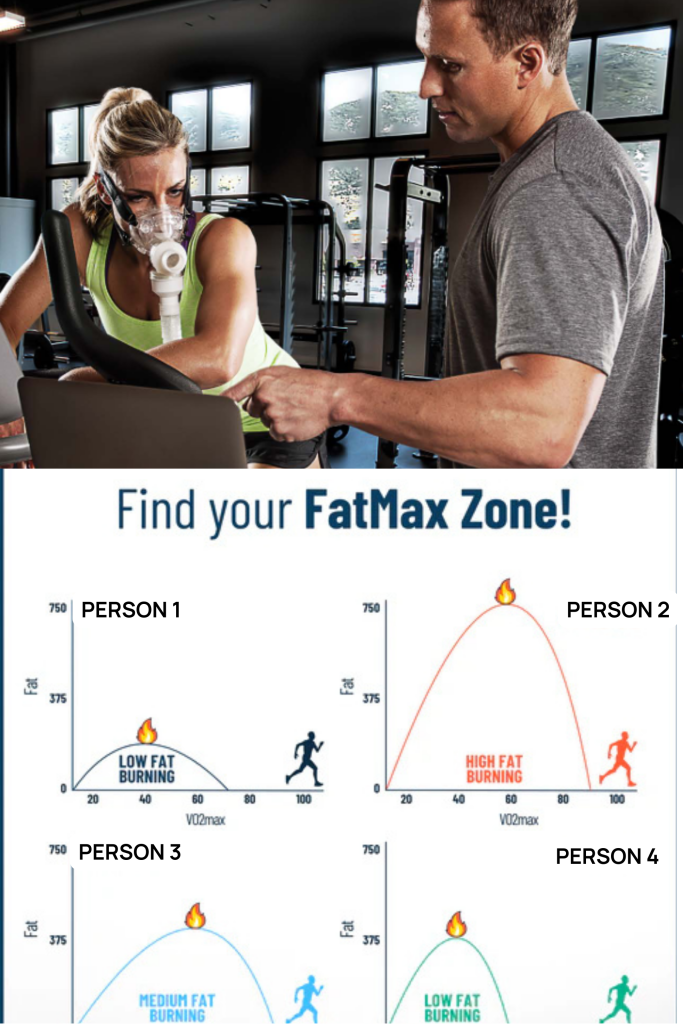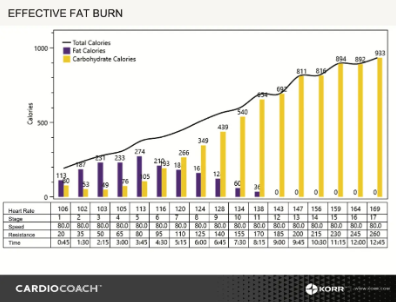What is the FatMax Test?
The FatMax Test measures your body’s ability to burn fat during exercise. It pinpoints the intensity where your body utilises the maximum amount of fat as a fuel source, helping you exercise smarter and achieve your goals efficiently.
Why Take a FatMax Test?
- Weight Loss: Exercise at the right intensity to maximise fat burning.
- Endurance Performance: Fine-tune training to improve endurance and energy management.
- Personalised Training: Tailor your routine based on your unique metabolic profile.
- Smarter Nutrition: Plan your diet and fuelling strategies based on fat vs. carbohydrate usage.
Who Should Take the FatMax Test?
This test is perfect for:
- Weight Loss Seekers: Maximise fat loss with targeted workouts.
- Fitness Enthusiasts: Make workouts more efficient and goal-driven.
- Endurance Athletes: Optimise glycogen preservation and performance in long events.
- Health-Focused Individuals: Enhance metabolic health for sustained energy and well-being.

Test Protocol
Preparation
- Equipment Setup: We’ll fit you with a mask to capture exhaled air and attach monitors to track your heart rate.
Warm-Up
- Perform 5-10 minutes of low-intensity activity: (e.g., walking, light cycling) to prepare for the test.
Testing Phase
- Starting Point: Begin at a manageable intensity (walking, jogging, or cycling with low resistance).
- Incremental Increases:
- On the treadmill: Increase speed or incline every 1-3 minutes.
- On the Watt Bike: Gradually increase resistance or cadence in stages.
3. Continuous Monitoring: Track oxygen consumption (VO2), carbon dioxide production (VCO2), heart rate, and perceived exertion throughout.
Stopping Points
The test concludes when one or more of the following is identified:
- FatMax: The intensity at which fat burning is maximized.
- Anaerobic Threshold: The point where lactic acid starts to accumulate, signaling a shift toward anaerobic metabolism.
- Inflection Point for External Fuel: The intensity at which carbohydrate utilization surpasses fat burning, indicating the need for external fuel sources (e.g., carbohydrates) to sustain activity.
This comprehensive stopping criterion ensures accurate insights for optimizing endurance, energy management, and fueling strategies.
Cool-Down
- Perform 5-10 minutes of light activity: Gradually reduce heart rate and blood pressure.
Results and Insights
Participants receive a detailed report, including:
- Fat-Burning Zone: Identify the heart rate and intensity where fat utilization is maximized.
- Fuel Utilization Data: Breakdown of calories burned from fat vs. carbohydrates at various intensities.
- Training Recommendations: Tailored advice on exercise intensity and duration to optimize fat burning.
As part of your appointment, we will walk you through your results, providing personalized recommendations and actionable steps to help you achieve meaningful improvements.
FAQ
How long does a FatMax Test take?
- The total appointment will be about 1 hour. The main exercise component of the test is typically 15-20 minutes in duration
How should I prepare for the test?
- For best results, avoid food, tobacco, alcohol, and caffeine for at least 3 hours before testing.
- Wear comfortable exercise clothing suitable for treadmill or bike exercise.
How often should I take a FatMax test?
- It’s recommended to retest every 6-12 months or after significant changes in training, fitness level, or body composition.
Should I take the test on the treadmill or exercise bike?
- Choose the equipment that aligns with your primary sport or activity for the most relevant and actionable results. If unsure, contact us and we can help you decide.
- Treadmill: Best for runners, walkers, or weight-bearing activities; offers higher VO2 results but involves more joint impact.
- Exercise Bike: Ideal for cyclists, triathletes, or low-impact training; better for those with joint concerns or injuries.
Is the test suitable for beginners?
- Yes, the FatMax test is suitable for all fitness levels as it focuses on submaximal intensities rather than pushing you to exhaustion.
What are the differences & similarities between Max VO2, FatMax, and Lactate Tests?
| Aspect | Lactate Threshold | FatMax | Max VO2 |
|---|---|---|---|
| Purpose | Identifies the intensity where lactate starts to accumulate faster than it can be cleared. | Determines the intensity where fat burning is maximised. | Measures the maximum oxygen your body can use during exercise. |
| Key Reasons for Test | Optimise endurance performance and delay fatigue. | Assess fat-burning efficiency. | Assess aerobic fitness and overall cardiovascular performance limits. |
| Primary Metric | Blood lactate levels vs. exercise intensity | Fat-to-carbohydrate fuel utilization ratio | VO2 (oxygen uptake) and VCO2 (CO2 output) |
| Outcome | Optimise training zones to delay fatigue and improve endurance. | Identify heart rate zones for fat loss and energy efficiency. | Assess aerobic capacity and overall cardiovascular fitness. |
- Each test provides valuable, specific insights, but combining them creates a holistic view of aerobic fitness, energy efficiency, and performance thresholds, allowing for highly targeted training and nutrition strategies.

